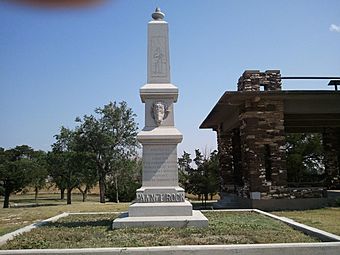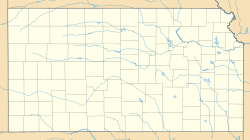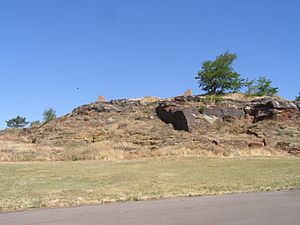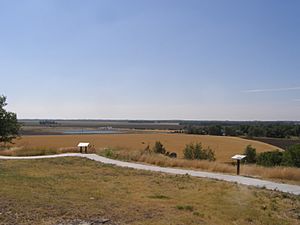Pawnee Rock facts for kids
Quick facts for kids |
|
|
Pawnee Rock
|
|

Monument at Pawnee Rock
|
|
| Nearest city | Pawnee Rock, Kansas |
|---|---|
| NRHP reference No. | 70000247 |
| Added to NRHP | December 29, 1970 |
Pawnee Rock is a famous landmark in Kansas, United States. It's found in Pawnee Rock State Park, near the town of Pawnee Rock, Kansas. This special rock was once a very important spot on the historic Santa Fe Trail.
Long ago, Pawnee Rock was over 150 feet (about 46 meters) tall. But when railroads were built, some of the rock was used for the train tracks. This made the rock a bit shorter, losing about 15 to 20 feet (4.5 to 6 meters) of its height.
Today, you can find a monument, a picnic area, and a pergola on top of the rock. From the pergola, you can see the Arkansas River valley. You can also spot the old route of the Santa Fe Trail. The rock now rises about 50 to 60 feet (15 to 18 meters) above the flat plains around it. Many years ago, a traveler named Matt Field described it as "a huge wart from the carpeted green of the prairie."
People who traveled the Santa Fe Trail, like traders and soldiers, often stopped here. They carved their names into the brown sandstone. Some of these old names can still be seen today, mixed with newer carvings. Pawnee Rock was added to the National Register of Historic Places around 1970. The Kansas Historical Society now looks after it as the Pawnee Rock State Historic Site.
Pawnee Rock's History
For a very long time, Pawnee Rock was a significant meeting place for different Native American tribes. These included the Comanche, Kiowa, Arapaho, and Cheyenne people. Many battles were fought near Pawnee Rock between these tribes. Because of this, many old bones have been found in the soil nearby.
The rock was also a place where tribes held important meetings. They discussed both war and peace there. Before white settlers came to Kansas, many Native American battles happened close to the rock.
A Lookout and Landmark
Pawnee Rock was a great lookout point for travelers on the Santa Fe Trail. It was also a place where Native Americans would gather or set up ambushes. For travelers, camping near the rock offered some safety from hostile tribes. Many people on the Santa Fe Trail thought Pawnee Rock was the most dangerous spot on the Central Plains. This was because of possible encounters with Native Americans.
Many Plains tribes used the rock as an observation point. From here, they could watch for buffalo herds or wagon trains. Then, they would "swoop down" on them. It was also an important landmark for travelers. It marked the halfway point between Missouri and Santa Fe. In 1848, a soldier named James Birch wrote that Pawnee Rock was "covered with names carved by the men who had passed it." He said it was so full he couldn't find a spot for his own name.
In the 1870s, much of Pawnee Rock was destroyed. Railroad builders used its stone for tracks. Settlers also took stones for building. What was left of the rock was bought in 1908 by the Woman's Kansas Day Club. In 1909, they gave it to the State of Kansas as a historic site.
On May 24, 1912, a stone monument was dedicated at the site. There was a big celebration with about 8,000 people watching. Pawnee Rock was officially listed on the National Register of Historic Places in 1970. Today, it is known as the Pawnee Rock State Historic Site.
How Pawnee Rock Got Its Name
There are many stories about how Pawnee Rock got its name. One idea is that it was sacred ground for the Pawnee people. They supposedly held their tribal councils on its flat top. Another story from Pawnee lore tells of a big battle. In this battle, a small group of Pawnees was defeated by a larger force of Kiowa, Cheyenne, and Arapaho warriors.
Among the early plainsmen, it's said the rock got its name in 1826. A famous frontiersman named Kit Carson was on his first trip west. He was only seventeen years old. He was working with a wagon train near the rock. While on guard duty, he accidentally shot his own mule. He thought it was an attacking Pawnee warrior. His friends then named the spot Pawnee Rock to remember his experience.





